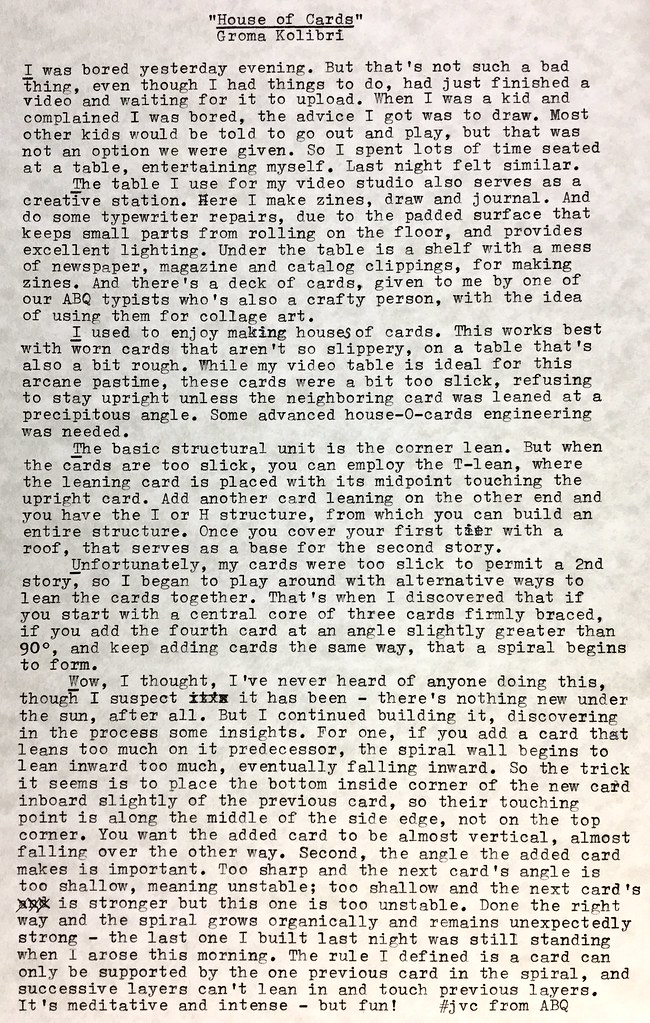House of Cards



As soon as I saw the spiral begin to form, my thought was on labyrinths, which are distinct from mazes in that labyrinths have only one path to the goal, with no branching decision points. Perhaps I can work further on this spiral technique to make paths that fold back and forth, left- and right-wise, instead of spiraling in one direction only. The structural challenge will be making the wall begin to lean the other way as it turns the corner.
This reminds me of drawing mazes, another tabletop youthful pastime. As a kid I'd developed the technique of the double- and triple-spiral: three or four paths, folding themselves inward to a common meeting point in the middle, that then serves as a common branching node. A single-path spiral is merely a dead-end - once in the middle, you have to retrace your steps backwards to get out; whereas with a double- or triple-spiral you have a branching decision to make once in the middle.
I once drew a maze that was about 10 feet long, on sections of notebook paper taped together, using a blue Bic Cristal medium ballpoint. This was during the summer between 8th & 9th grade, when I was recuperating from surgery on a ruptured, infected appendix that came close to killing me. The maze was essentially a mass of double- and triple-spirals, connected together in a complex topology. I also figured out you could draw a very tightly-wound double spiral, one difficult to trace without the aid of a pointer or pen. Then, the adjoining paths in the spiral could be deadend together into a loop, that doesn't connect anywhere else; if you mistakenly crossed over the correct path into said no-man's land, you'd never find your way out without starting over. Devious, yes.
I carried that 10 foot long maze around campus in 9th grade as a scroll, a private badge of honor reminding me that, despite my surgery and recuperation being a handicap upon entering high school, my one advantage was obscurity: instead of competing with other students on an equal playing field, I invented my own playing field.
The thing about spirals and labyrinths - or houses - made from cards is the gaps between the panels, caused by the necessity to lean them one against the other, breaks the illusion of a solid structural wall. One is tempted to cross through a gap in a wall, to cheat a little bit. Hence the reason for groundrules to the game. The other option is to take a razor knife and perform surgery on your deck(s) of cards with interlocking slots, which makes them much more structurally solid but also removes any sense of challenge that is essential to the art of building a House of Cards, that being their difficulty in remaining upright against the forces of gravity and coefficients of friction. Like all engineering challenges, they are a balance between competing forces, that's why they're so fun.
Getting back to that spiral labyrinth of cards, a rigid central starting point is essential to success. But I can imagine you could alternatively start with a rigid external starting point instead, and wind your spiral inward to a cleanly defined ending card. Or, with enough cards, make that double- or triple-spiral, multiple card helixes winding themselves inward to a common central nodal point. But I'll leave that to you, the dear reader, to attempt. Unless I get around to it first.
Labels: Mazes, paper craft

1 Comments:
"instead of competing with other students on an equal playing field, I invented my own playing field."
Now that's something I've always tried to practice in my life. :D
Post a Comment
<< Home